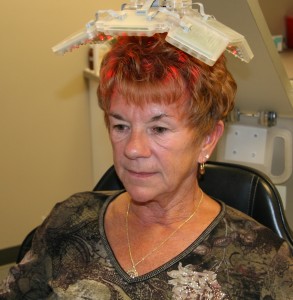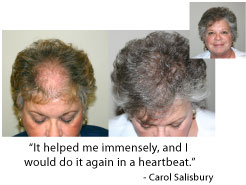It’s Not Your Grandmother’s Hair Transplant
So, what are the sound medical and scientific treatments of female pattern hair loss?
As was discussed in my prior blog: “Women Don’t Lose Their Hair—NOT”, there are dual goals in my approach to treat women with thinning hair.
The first (and one that is very, very important) is to slow down or to stop the progression of female pattern hair loss, which, for sure, is a progressive condition. For most women, there are two options, which both can slow down hair loss and can re-grow hair.
A long-proven, highly effective medical treatment for this purpose is Rogaine. This medication has been available in the United States for more than 20 years. It does a fantastic job to slow hair loss (shedding) and a good job to actually re-grow hair that has become miniaturized to the point that it is not visible to the human eye.
Believe it or not, after 50 percent of hair has already fallen from a woman’s scalp, is when she even begins to notice her hair thinning! That means that a tremendous amount of hair is already gone when it thinning becomes recognized.
 Women know their own hair. They know that it is thinning before anyone else does. In fact, they ask their hair stylists or their family member or their friends or their doctors about it—all of whom tell them that they are crazy! With my 27 years in treating women with hair loss, I do not think they are crazy—at least not because they think their hair is thinning!
Women know their own hair. They know that it is thinning before anyone else does. In fact, they ask their hair stylists or their family member or their friends or their doctors about it—all of whom tell them that they are crazy! With my 27 years in treating women with hair loss, I do not think they are crazy—at least not because they think their hair is thinning!
Can you see your scalp through the front of your hairline now when it was not possible to do so in the past? Is your ponytail significantly thinner in diameter than before? Does sun shining through your moon roof reflect through your hair that now can be seen in your rearview mirror? Did your scalp get sunburnt this summer? Are people looking at your hairline instead of looking into your eyes during conversations? Did some jerk ask you if you were going bald? These are all comments that my patients tell me how their thinning hair became noticeable to them.
So, what are the medically proven treatments for women with hair loss?
1. ROGAINE
2. LOW LEVEL LASER THERAPY
3. FINASTERIDE (only for some women)
4. HAIR TRANSPLANTATION
ROGAINE:
There are some very important things that you must know about using Rogaine before you begin this successful treatment for hair loss:
1. It takes a long time before it becomes clinically effective. It takes at least 4 months to even to start to slow down hair loss! And at least 12 month to see re-growth. So many people have come into my office indicating that they used Rogaine, but “it didn’t work”. What happened was that they didn’t use it nearly long enough; they stopped it even before it could work medically. This is much, much more common than anything else about its use.
2. You have to apply it properly. I teach my patients exactly how to use it during their consultation. It is cumbersome at first, but after a few days, it really should take them about 10 seconds to apply it.
3. It needs to be used twice a day—every day! Enough said! That’s the proper dosing of this medication to be fully effective.
4. It has to be used over the long term. Once you begin this treatment, it has to be used as long as you want to continue to have your hair. Yes, for years. Don’t ever forget, though, that female pattern hair loss continues to get worse if not treated for your lifetime!
5. If you stop using it, all of the benefits it provided for you will reverse. That’s right; if you don’t use; you’ll lose it. This is one of the biggest points of resistance to beginning Rogaine I get from women. For goodness sakes, you use deodorant, toothpaste and makeup forever. If you stop these, it would not be a pretty situation—right? Rogaine SAVES YOUR HAIR!
6. That’s about it!
LOW LEVEL LASER THERAPY:
 The second option that is available to treat hair loss in women is Low Level Laser Therapy (LLLT). We have offered this very effective therapy to our patients for the last 13 years. There are two laser therapy options available today: the office-based protocol and the new Auto A300 laser cap home-use device. Each option is equally effective as the other IF the patient faithfully uses the cap. With LLLT, it is important to be consistent in its use. Additionally, it is important not to use it longer per treatment or more treatments per week. The other thing that is important is that if you travel to the Cape or to Tokyo—you need to bring it with you. Consistency is imperative!
The second option that is available to treat hair loss in women is Low Level Laser Therapy (LLLT). We have offered this very effective therapy to our patients for the last 13 years. There are two laser therapy options available today: the office-based protocol and the new Auto A300 laser cap home-use device. Each option is equally effective as the other IF the patient faithfully uses the cap. With LLLT, it is important to be consistent in its use. Additionally, it is important not to use it longer per treatment or more treatments per week. The other thing that is important is that if you travel to the Cape or to Tokyo—you need to bring it with you. Consistency is imperative!
FINASTERIDE:
The last treatment option for some women is Finasteride, which is NOT FDA-approved in women. The reason for this is that, if a woman of childbearing age were to take this pill while she was pregnant, a birth defect could occur. Women who are outside of the childbearing years may benefit from this medication.
HAIR TRANSPLANTATION or HAIR RESTORATION SURGERY:
The last, but certainly not least treatment for hair loss in women, is Hair Transplantation or Hair Restoration Surgery. A rather large percentage of my personal surgical practice is devoted to surgical hair restoration in women.

A woman has got to have realistic expectations as to what this premier solution to hair loss can provide for her. At the very least, hair transplantation will provide her with more hair with which to style. Sometimes just a relatively small amount of growing hair is enough for her to be able to effectively camouflage her thinning areas.
That having been stated does not mean that significant hair restoration is not possible in women. To the contrary, I can repopulate ever-growing hair to areas of frontal recession, central frontal balding, top loss, as well as thinning or baldness in the crown area—if she has adequate donor density to provide what she needs. It is only during a private hair loss consultation that this can be determined.
In summary, it is critically important to stop progression of this ever-worsening condition with medically and scientifically sound options. Don’t fall prey to sales pitches and too-good-to-be-true advertisements in print, on the radio, on television, and/or on-line that purport to stop hair loss or to re-grow hair. You will be totally wasting your hard-earned money on these and will be dreadfully disappointed when they don’t do anything to positively affect your hair loss situation!
![]()

